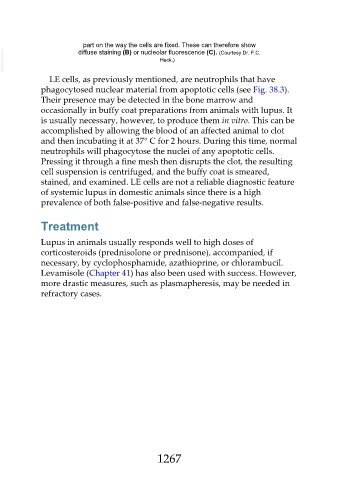Page 1267 - Veterinary Immunology, 10th Edition
P. 1267
part on the way the cells are fixed. These can therefore show
VetBooks.ir diffuse staining (B) or nucleolar fluorescence (C). (Courtesy Dr. F.C.
Heck.)
LE cells, as previously mentioned, are neutrophils that have
phagocytosed nuclear material from apoptotic cells (see Fig. 38.3).
Their presence may be detected in the bone marrow and
occasionally in buffy coat preparations from animals with lupus. It
is usually necessary, however, to produce them in vitro. This can be
accomplished by allowing the blood of an affected animal to clot
and then incubating it at 37° C for 2 hours. During this time, normal
neutrophils will phagocytose the nuclei of any apoptotic cells.
Pressing it through a fine mesh then disrupts the clot, the resulting
cell suspension is centrifuged, and the buffy coat is smeared,
stained, and examined. LE cells are not a reliable diagnostic feature
of systemic lupus in domestic animals since there is a high
prevalence of both false-positive and false-negative results.
Treatment
Lupus in animals usually responds well to high doses of
corticosteroids (prednisolone or prednisone), accompanied, if
necessary, by cyclophosphamide, azathioprine, or chlorambucil.
Levamisole (Chapter 41) has also been used with success. However,
more drastic measures, such as plasmapheresis, may be needed in
refractory cases.
1267

